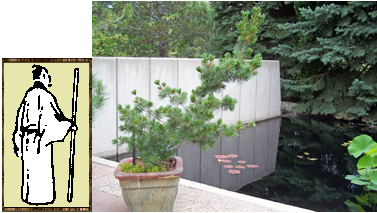
Hexagram Eight—Groups
Hexagram Eight discusses the accord between members of a family, state, or society. If all signs indicate the leader is virtuous and worthy, people will respect the leader. Those who remain skeptical are unlucky because they will lose their way.
The first line, yin, shows one whose heart is a vessel filled with sincerity. Accord with such a person brings good fortune, so it is wise to go out of one's way to encourage harmony.
The second line, yin, shows true harmony with external forces must begin within. Such a fortunate person maintains an attitude of honesty, sincerity, and straight forwardness.
The third line, yin, shows it is useless to strike an accord with someone who has evil objectives. Show tolerance, but don't accept such a person into confidence.
The fourth line, yin, says it is wise to seek accord with those who are in a more advanced state of knowledge or consciousness.
The fifth line, yang, shows a king chasing game in three directions, but because the townspeople understand he is hunting, they do not become alarmed. The subject has made their intentions clear so people are ready for what happens next.
The sixth line, yin, says harmony alone is not enough. There must be forward movement or nothing is accomplished.
Hexagram Eight Commentary
Hexagram Eight looks at the relationships between members of a family, state, or society. The order within the group is attributed to good leadership. When the leader is benevolent, it's good to follow the leader. People who reject good leadership will lose their way.
The first line, yin, shows a sincere person acting to bring harmony to a group. Working together with such people brings stability and progress.
The second line, yin, speaks of the inner and outer reality. In this case, people's inner harmony contributes to social harmony. This becomes a positive feedback loop, so honest people may live in a social structure that mirrors their own sincerity and ability to communicate to resolve problems as they arise.
The third line, yin, explains how honest people treat people who have ulterior motives and evil intentions. It's good to show tolerance, but it would be useless to try to come to an agreement with negative people, or accept them into confidence.
Rather than try to change ill-intentioned people, the fourth line, yin, recommends seeking accord with people who are more mature, who have attained a higher state of consciousness. This is similar to modern self-help advice. Instead of trying to change somebody, it is better to decide whether to keep that person as a friend. If so, it is essential to accept the person as they are. If not, shed draining relationships and open the door for more compatible friends.
The fifth line, yang, explains leaders must be transparent and accountable to their followers. They must share their plans and goals. The metaphor is of a king running through the forest with a weapon, "chasing game in three directions." However, because the king's intentions are clear, the townspeople are not alarmed.
The sixth line, yin, explains the real test of a group is not the level of harmony, but how much it accomplishes. Forward movement—progress—is the real test of a successful society.
To the reader: Most of the hexagrams have at least one line that predicts bad results, but that does NOT mean you are fated to that result. The hexagrams illustrate different attitudes, so study the actions and reactions to learn the attitudes that will lead to better outcomes.
The I Ching teaches you to flow with changes and create positive change from the inside through conscious living. Your future is in your hands. Consult the I Ching for ideas that lead to clear thinking and positive mental attitude. Reading the I Ching helps you take the time to reflect on your attitudes and ideas. Continue asking until you feel positive about your course.

Click here for another hexagram.
A note about this interpretation of the I Ching: Nori Muster wrote this version of the I Ching in 1994 and put it online at Surrealist.org in 2000. It is also available at Amazon:
e-book
paperback
